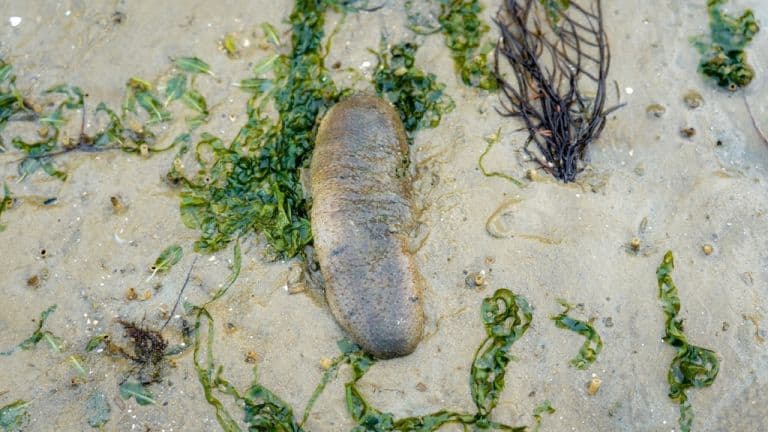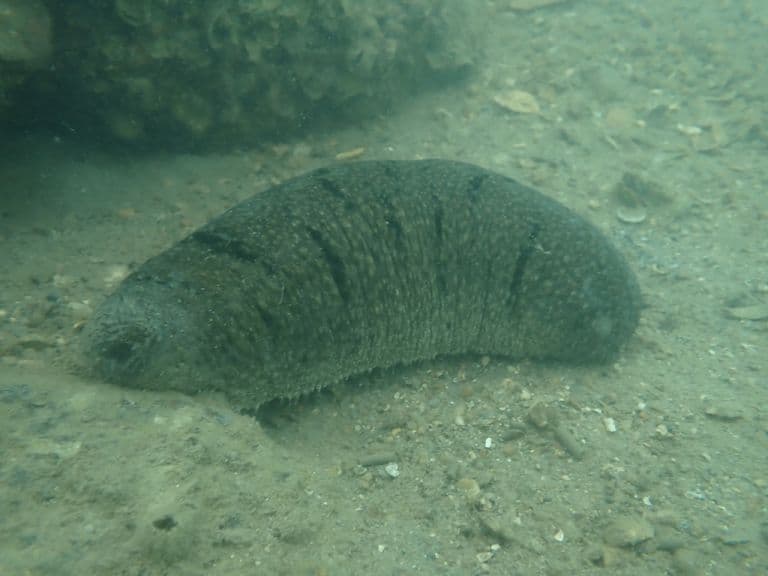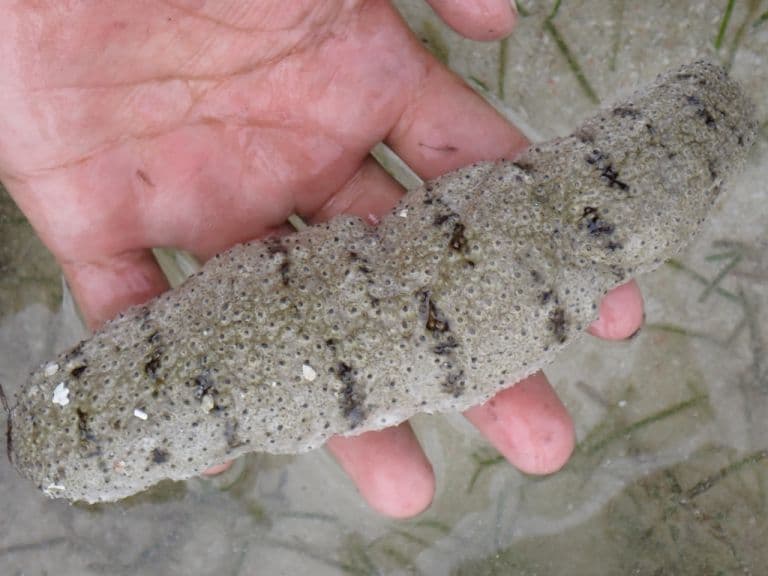Sandfish Profile
Rarely is there any animal with such a wealth of nicknames, each of which is more appetising than the last. The sandfish, also known as the Jongoo, golden sandfish, garlic bread sea cucumber and bald ginseng, is miraculously just as appealing as it sounds.
This unassuming sea cucumber is one of the most popular seafood products in various parts of Asia, and this is causing the poor thing a lot of problems.

Sandfish Facts Overview
| Habitat: | Shallow tropical waters |
| Location: | Indo-Pacific region, from east Africa to the eastern Pacific, |
| Lifespan: | At least 10 years |
| Size: | some reaching up to 40 cm (16 inches) |
| Weight: | Up to 400g (14 oz) |
| Colour: | Grey or brown, sometimes striped |
| Diet: | Sea grass, detritus, plankton, other organic matter |
| Predators: | Sea turtles, sharks, other fish, crustaceans, mangrove snails |
| Top Speed: | Almost sedentary |
| No. of Species: | 1 |
| Conservation Status: | Endangered (IUCN) |
Sandfish – at least, this “Sandfish” – are a species of sea cucumber found between East Africa and Asia. They’re shallow water loungers, mostly feeding on seagrass and minding their own business.
The same can’t be said for their predators though, whose persistence allows them to overcome the cucumber’s vomit defence and eat it anyway.
Sadly, they taste really, really, good. And this has led to the species being entirely overharvested and now they’re on the way out.
Interesting Sandfish Facts
1. Garlic bread sea cucumbers
With such a basic nickname, you probably wouldn’t be surprised to find that there are a number of animals also called sandfish. At least one is so far removed from fish that it doesn’t even live in water, but in this instance, the sandfish in question is Holothuria scabra, a sea cucumber.
Of course, this isn’t a fish or a cucumber, but it does at least live in the sea. Some call it the garlic bread sea cucumber, which refers to its loaf-shaped, square-ended body.
As a sea cucumber, this is more closely related to a starfish and a sea urchin than anything its nicknames suggest and spends much of its time moving at a barely noticeable crawl along the sea bed. 1

2. They’re not in a hurry
Such a slow-moving animal prefers low-energy environments. Anything with too much of a current would be a little too exciting for this cool cucumber, and so it spends its days in the sandy reef environment, in lagoons and mangroves, estuaries and other gentle places.
Some are even found in shallow seagrass beds, which appear to be a favourite spawning site, on account of the lack of predators. 2
3. They go through many stages
After spawning in these calm, protected areas, larvae are produced. These planktonic animals can’t swim much, so are at the mercy of the currents. They eat seagrass until they’re about a centimetre long.
At this point, their strategy changes, and they enter a non-feeding stage and then another planktonic feeding stage, before maturing as juvenile garlic bread and settling on the ocean floor.
In all, there are six stages to this life cycle, and once the cucumber is a juvenile it matures into a full-sized animal over the course of two years.
These strange creatures are still not fully understood and generational length remains a mystery. It’s also impossible to tell how old one is by looking at it.

4. They have tentacles
It’s hard to say which is the ‘front’ end of an echinoderm but for argument’s sake, let’s say it’s where the mouth is.
At the front end, the sandfish has around 20 short tentacles that are used to manipulate food into the mouth. 3
5. They vomit defensively
Like other sea cucumbers, this one has a highly effective deterrent. When threatened, it will eject its organs out of its mouth, disgusting any sensible predator and permanently ruining their appetite for the animal.
Or at least, that’s the reasonable response, but for some reason, people still eat them.
Wholesale prices are up to $300 per kilo of dried sandfish, marketed as something called “Bald ginseng”, yet another highly deceptive name.
6. They’re a popular food
As delicious as garlic bread is, this echinoderm does not have an appetising look to it. Still, it’s been a recognised source of seafood for humans for at least a thousand years.
But it’s not only people who eat them, mangrove snails are one of these slow-moving sausages’ most dangerous predators as juveniles. Nile tilapia are also a threat and adults are further predated upon by sea turtles, large fish and crustaceans.
But none of these animals threatens the species as much as the human harvest does.
7. They are being fished to extinction
Commercial harvest of sandfish has become a serious problem. As such a valuable species, they are now intensively exploited in multiple countries for the Asian market.
On top of deliberate exploitation comes the detrimental effect of bycatch, as increasingly, prawn nets are bringing up sea cucumbers by mistake. As a result of this, the species is now considered endangered and in decline. 4

Sandfish Fact-File Summary
Scientific Classification
| Kingdom: | Animalia |
| Phylum: | Echinodermata |
| Class: | Holothuroidea |
| Order: | Holothurida |
| Family: | Holothuriidae |
| Genus: | Holothuria |
| Species: | Holothuria Scabra |
Fact Sources & References
- (2020), “Garlic bread sea cucumber”, Wild Fact Sheets.
- “Holothuria scabra”, IUCN Red List.
- “Sandfish”, Jungle Dragon.
- “Holothuria scabra”, IUCN Red List.
